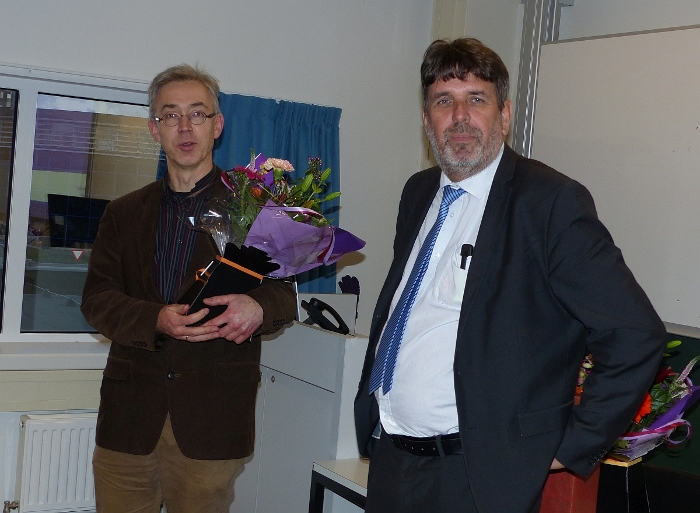
Stans Prize 2017 for Davide De Mauro
The ‘Stans Prize 2017' (for the best thesis, report or article produced by a CML student) has been awarded to Davide De Mauro. Other CML prizes were awarded to Jeroen Guinee, Reinout Heijungs, Martina Vijver, Willie Peijnenburg en Kevin Groen
- Stans Prize 2017
- Summary of the report of Davide
- Other CML publication prizes for 2017
- Constance (Stans) Eikelenboom
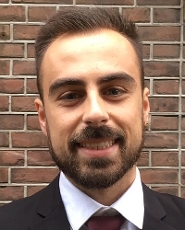
Stans Prize 2017
Davide De Mauro received the Stans Price for his Master Thesis called: "Quantitative Scenario Analysis of the Dutch dairy chain- Assessment of the effectivness of circular strategies to solve environmental problems associated to nitrogen and phosphorus flows”. Davide has done the Master Industrial Ecology.
The Stans Prize is a yearly student incentive award for the best thesis, article or report produced by a CML student. The prizes were presented at the CML New Years Meeting on January 19, 2018. Davide has given a short presentation about his Master research.

Summary of the report of Davide
Agri-food systems are currently in an era of re-modernization that is forcing them to move towards more sustainable and resilient management configurations. In fact, they are now facing a large variety of challenges from increasing adverse climate conditions to energy security issues and the goal of combating hunger across the world. One of the challenges consists of establishing resource-efficient food systems where food losses and waste are minimized along the entire supply chain, and environmental impacts are reduced. In line with this, principles from the Circular Economy field have been started to be applied to agri-food economic activities. There is a shared agreement amongst scientists that circular management strategies applied to the agri-food sector could help to minimize the need for external resources by preventing losses meanwhile reducing the environmental impacts generated along the food supply chain. However, this positive link between circularity and environmental gains must be quantitatively assessed. This study aims to evaluate to what extent the implementation of alternative circular management regimes can lead to reducing the current environmental impacts of the Dutch dairy chain associated with nitrogen (N) and phosphorus (P) flows. N and P are two essential elements for agricultural activities, and solutions must be found to increase the efficiency of their cycle throughout food chains. It is well-known that an excessive use of nutrients contributes to several environmental problems, including acidification, eutrophication, global warming and rock phosphate depletion. To understand the magnitude of N and P stocks and flows in 2014 in the Dutch dairy sector and to identify the major problematic issues, a Substance Flow Analysis (SFA) was performed with a combination of accounting and static modeling techniques.
The Substance Flow Analysis has shown a certain degree of openness of the Dutch dairy sector, mainly due to the international nature of the Dutch dairy market, its significant dependency on imported resources and the current low recycling rate of certain waste flows. In fact, of the 368 ktonsN and 35 ktonsP entered in the Dutch dairy chain in 2014, the majority of the nutrient input consisted of imported concentrate feed, synthetic fertilizers, imported manure and dairy products. Considering a steady-state situation, the total nutrient output of the Dutch dairy chain was estimated at 332 ktonsN and 26 ktonsP, mainly consisting of exported manure and dairy products, nutrient lost in ashes of incinerated sewage sludge and nitrogen emissions (especially ammonia, nitrates and atmospheric nitrogen). An overall accumulation of 130 ktonsN was estimated in Dutch dairy soils in 2014, which translates into 33 ktonsN leaching and the rest emitted in other N-forms. For phosphorus, an average negative accumulation (-6 ktonsP) was estimated. Finally, 36 ktonsN and 8.4 ktonsP accumulated in cow’s body along the year.
Once all the output data were estimated, a steady-state model was created in order to be used for the Scenario Analysis. The reliability of the model was evaluated by cross-checking the output variables estimated with bottom-up approaches with country-specific top-down data gathered from national statistics. The ‘scenarios’ proposed in this research are not real future situations but rather alternative management regimes of the current situation. Three alternatives are proposed: the fully Organic, the Hi-tech and the Hybrid scenarios. According to the nature of the scenario, different circular strategies are proposed based on current trends in the Dutch dairy sector. The environmental and circularity performances of the scenarios are evaluated with the use of defined indicators. All the proposed scenarios have demonstrated to generate a considerable reduction of current environmental problems and an increased independence of the chain from external resources. The Hi-tech scenario is the one that performs the best as compared to the others, both from an environmental, economic and circularity point of view. However, many barriers rise from social acceptance of indoor livestock farming to the need for large capital investments. On the other hand, the Organic scenario has also shown considerable environmental gains, but at the expenses of an increased dependency on external organic fertilizers and a halved dairy market. The Hybrid scenario has demonstrated that also a partial simultaneous adoption of the proposed measures would considerably improve the current situation in terms of both circularity and environmental impacts associated with nitrogen and phosphorus flows.
In general, to enhance nutrient circularity and replace synthetic fertilizers and imported concentrate feed, the cascading recovering and recycling of nutrients from waste flows is crucial. The recovery of nutrients from incinerated sludge ashes, sludge from municipal and dairy WWTPs, and solid municipal organic waste and the large-scale implementation of upcycling technologies for cattle manure have both demonstrated high potentials for the achievement of the circularity target. This analysis has shown that an increased circularity degree of the Dutch dairy sector would come together with a considerable reduction of the environmental impacts associated with N and P flows, but without eliminating the issues. Moreover, further research is needed to assess how the proposed alternative regimes would perform regarding environmental issues such as global warming, energy consumption, fossil fuel use, water depletion, particulate matter emissions and others.
Other CML publication prizes for 2017
During the meeting also the other publication prizes were announced.
The Stans award for the best CML scientific publication
is for:
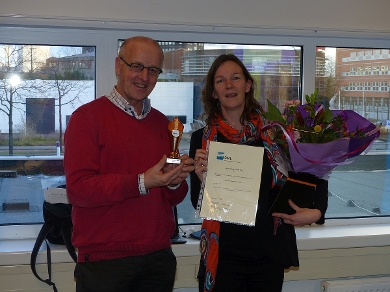
and Martina Vijver
- Setting the stage for debating the roles of risk assessment and life-cycle assessment of engineered nanomaterials by
Jeroen Guinee, Reinout Heijungs, Martina Vijver and Willie Peijnenburg (In: Nature Nanotechnology)
Jeroen Guinée and his CML inmates took up the challenge to cooperate between the two departments on a really high level. They managed to tie two important scientific methods (risk assessment and LCA) by sketching four schools of thought for combining and integrating both methods, specifically for the emerging field of nanomaterials.
The Stans award for the best outreach 2017
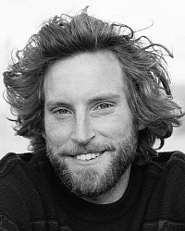
goes to:
- Kevin Groen (and his brother Marvin) for their media exposure around their column about 'Nature in the city' in the programme called 'Vroege Vogels' on the Dutch television.
Their unflagging enthusiasm attracted media attention and now they have had a column in a regular program. Being yourself on TV is not easy, but Kevin and Marvin have achieved this and given nature and environment a new podium on national tv.
Constance (Stans) Eikelenboom
The Stans Prize has been named after Constance Eikelenboom (nickname Stans)
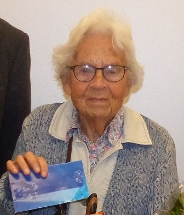
Who was Constance Eikelenboom?
She was an environmental toxicologist who did important work on dioxins whilst working. At the same time, she initiated several activities in the field of environmental toxicology, recently against the pollution caused by wastage of (car) tyre-products in football fields. In many ways to us, she resembled Rachel Carson, the author of Silent Spring (1962).
Some 30 years ago, looking at the course program herself, she approached CML of the opinion that the courses were not of sufficient high standard. In response, the then director of education, invited her to attend one of the courses and explore this herself. This resulted in her participation of the course in 1986 during which, she discovered that she liked it very much both regarding content as well as the active forms of student participation. This reflected in a substantial donation to the CML fund by means of the abovementioned prize (‘Stans Award’) when she reached retirement. Her aim was to raise the quality of student’s output by introducing a competition. CML is grateful for that gift which, so far has been awarded 33 times.
Sadly enough Constance Eikelenboom passed away on March 12 of last year at the
age of 95. The prize named after her is a lasting tribute to this remarkable woman.
CML is grateful to Stephan Slingerland, who donated last year to the Prize to honour Stans.
